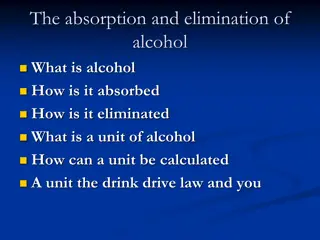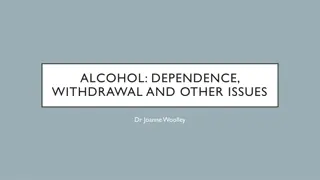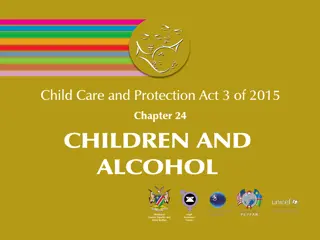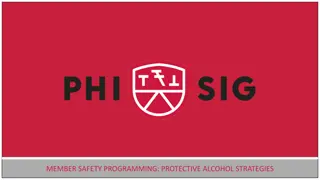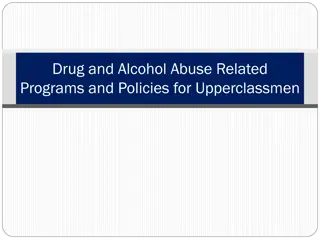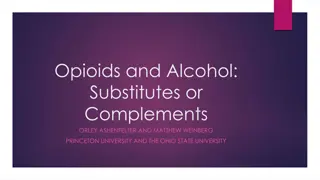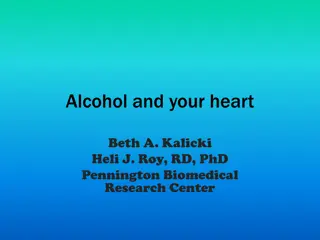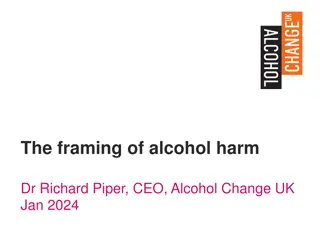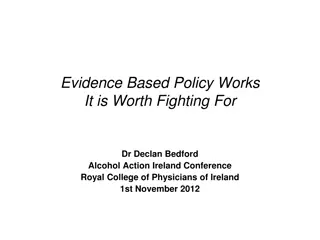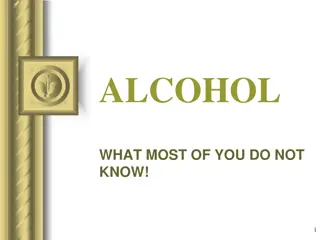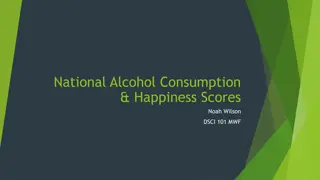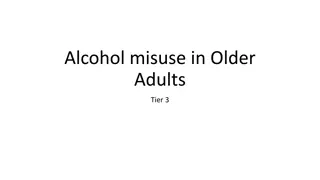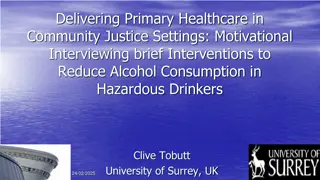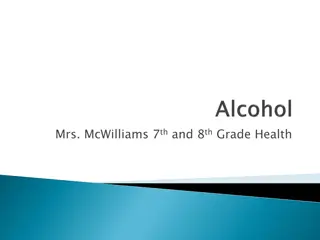
Insights into Global Alcohol Consumption Patterns
Explore the intricate landscape of alcohol consumption across countries, delving into factors such as income distribution, drinking preferences, demand elasticities, and the impact of pricing. Uncover data from 153 countries in 2011, previous studies on the subject, and preliminary tests of the Law of Demand. Gain insights into specialized drinking behaviors, such as spirits, wine, and beer intensity, and the covariation of quantities and prices of alcohol.
Download Presentation

Please find below an Image/Link to download the presentation.
The content on the website is provided AS IS for your information and personal use only. It may not be sold, licensed, or shared on other websites without obtaining consent from the author. If you encounter any issues during the download, it is possible that the publisher has removed the file from their server.
You are allowed to download the files provided on this website for personal or commercial use, subject to the condition that they are used lawfully. All files are the property of their respective owners.
The content on the website is provided AS IS for your information and personal use only. It may not be sold, licensed, or shared on other websites without obtaining consent from the author.
E N D
Presentation Transcript
1 UNDERSTANDING ALCOHOL CONSUMPTION ACROSS COUNTRIES Kenneth Clements, Yihui Lan and Haiyan Liu University of Western Australia
2 Introduction Alcohol and food consumption across income distribution, 153 countries in 2011 Item 1st quartile 2nd quartile 3rd quartile 4th quartile Food share (%) 11.4 21.0 31.1 45.8 Alcohol share (%) 1.4 2.4 2.3 2.2 Alcohol/Food (%) 12.5 11.4 8.2 4.9 Income (US=100) 66.6 34.3 19.3 5.5
3 Previous Studies Citations
4 GLOBAL ALCOHOL CONSUMPTION: PRIOR STUDIES Author(s) Author(s) Comments Comments Issue Gallet (2007) Fogarty (2010) Analytical estimates of demand elasticities for beer, wine and spirits summary of prior Meta Studies of Demand for Beer, Wine and Spirits Clements and E. A. Selvanathan (1987), E. A. Selvanathan (1991), Clements, Yang, and Zheng (1997), S. Selvanathan (2006) and S. Selvanathan & E. A. Selvanathan (2007) Drinking Patterns Internationally: Early Studies Tastes countries as judged by demand equations seem to differ across Anderson, Nelgen and Pinilla (2017), Anderson and Pinilla (2018) New Database and Analysis Extensive global wine database, 1860 to 2016. Case studies of wine production, consumption and trade for numerous countries Smith and Solgaard (2000), Bentzen, Eriksson and Smith (2001), Aizenman and Brooks (2008), Colen and Swinnen (2016), Holmes and Anderson (2017), Mills (2018), Anderson, Meloni and Swinnen (2018) Globalisation seems to lead to homogenisation patterns, especially for beer and wine. Still, some differences remain countries Cross-country similarities of consumption important between
5 Data Price and expenditure on alcoholic beverages from 153 countries in 2011 provided by World Bank. An example: US Half of alcohol expenditure on beer -> beer-intensive
6 Geometry of Drinking 100 61% countries are specialised drinkers Spirits Intensive 15 153= 9.8% 50 50 Wine Intensive Beer Intensive 13 153= 65 153= 8.5% 42.5% US 100 50 100 60 153= 39.2% Diversified
7 Preliminary Tests of the Law of Demand A Non-Parametric Approach LOD states that an increase in the price of a good results in a decrease in its consumption, real income held constant. Price relative to average Quantity relative to average Below Above I II Above IV III Below
8 The Covariation of Quantities and Prices of Alcohol Price relative to average Price relative to average Quantity relative to average Quantity relative to average Below Above Total Below Above Total A. Beer B. Wine Above 59 16 76 Above 21 5 26 Below 12 12 24 Below 11 63 74 Total 72 28 100 Total 32 68 100 C. Spirits D. Total Above 18 8 26 Above 33 10 43 Below 19 55 74 Below 14 43 57 Total 37 63 100 Total 47 53 100
9 An Index-number Approach LOD implies negative correlation coefficient between prices and quantities Divisia variance of prices and quantities 3 3 ( ) ( ) 2 2 = w log p -log P = w log q -log Q pc ic ic c qc ic ic c i=1 i=1 pqc = c Covariance of prices and quantities pc qc 3 = ( )( ) w log p -log P log q -log Q pqc ic ic c ic c i=1
10 Correlation between Prices and Quantities Histogram of the 153 correlation coefficients as follows: Histogram of corr[, 1] 86% = Mean 0.6 2.0 Density Density 1.0 0.0 -1.0 -0.5 Correlation coefficient c 0.0 0.5 1.0 corr[, 1]
11 A Demand System Modified Rotterdam Model Index of total alcohol = q Q 3 j + + + log log log ic w Q p ic i i c ij jc ic = 1 c Budget share of good i Substitution term Then, Income elasticity Homogeneity and Symmetry are not rejected ij 1+ i Slutsky price elasticity (total alcohol held constant) w w ic ic
12 Estimation Results Budget Shares (%) Slutsky Matrix ( 100) Price Elasticities Wine Spirits Beer Beer Wine Spirits 47.2 0.28 0.17 0.45 -21.5 (2.0) 8.1 (1.3) 13.4 (1.6) Beer 24.6 Wine -0.67 0.34 -16.5 (1.5) 8.4 (1.2) 0.33 28.2 0.30 Spirits -0.77 0.47 -21.7 (1.8)
13 Utility Interactions = f( , , ) Define to the Hessian matrix of the utility function , the inverse matrix is proportional ij ij i j Matrix ( 100) ij [ ] 1 Beer Wine Spirits Beer 0.65 -2.98 0 Wine 4.88 0 Spirits -3.97
14 Concluding comments 43% countries are beer-intensive, beer is the most popular alcohol. Preliminary tests support the Law of Demand. The own-price elasticity for beer, wine and spirits are negative and not far from 0.6. Beer, wine and spirits are substitute for each other.
15 References Aizenman, J., and E. Brooks (2008). Globalization and Taste Convergence: The Cases of Wine and Beer. Review of International Economics 16: 217-33. Anderson, K., G. Meloni and J. Swinnen (2018). Evolving Consumption Patterns, Regulations and Industrial Organization of the Global Alcohol Market. Wine Economics Research Centre, University of Adelaide, Working Paper No. 0218. Anderson, K, S. Nelgen and V. Pinilla (2017). Global Wine Markets, 1860 to 2016: A Statistical Compendium. Adelaide: University of Adelaide Press. Anderson, K., and V. Pinilla (2018). Wine s Evolving Globalization. Cambridge: Cambridge University Press. Bentzen, J., T. Eriksson V. Smith (2001). Alcohol Consumption in European Countries. Cahiers d Economie et Sociologie Rurales 60/61: 50 75. Clements, K. W., and E. A. Selvanathan (1987). Alcohol Consumption. Chapter 5 in H. Theil and K. W. Clements, Applied Demand Analysis: Results from System-Wide Approaches. Cambridge, Mass.: Ballinger. Clements, K. W., W. Yang, and S. W. Zheng (1997). Is Utility Additive? The Case of Alcohol. Applied Economics 29: 1163-67. Colen. L., and J. Swinnen (2016). Economic Growth, Globalisation and Beer Consumption. Journal of Agricultural Economics 67: 186 207. Fogarty, J. (2010). The Demand for Beer, Wine and Spirits: A Survey of the Literature. Journal of Economic Surveys 24/3: 428- 78 Gallet, C. A. (2007). The Demand for Alcohol: A Meta-Analysis of Elasticities. Australian Journal of Agricultural and Resource Economics 51:121-35. Holmes, A., and K. Anderson (2017). Convergence in National Alcohol Consumption Patterns: New Global Indicators. Journal of Wine Economics 12: 117-48. Mills, T. C. (2018). Is there convergence in national alcohol consumption patterns? Evidence from a compositional time series approach. Journal of Wine Economics 13: 92-98. Selvanathan, E. A. (1991). Cross-Country Alcohol Consumption Comparison: An Application of the Rotterdam Demand System. Applied Economics 23: 1613-22. Selvanathan, S. (2006). How Similar are Alcohol Drinkers? International Evidence. Applied Economics 38: 1353-62. Selvanathan, S., and E. A. Selvanathan (2007). Another Look at the Identical Tastes Hypothesis on the Analysis of Cross- Country Alcohol Data. Empirical Economics 32: 185-215. Smith, D. E., and H. S. Solgaard (2000). The Dynamics of Shifts in European Alcoholic Drinks Consumption. Journal of International Consumer Marketing 12: 85 109.


